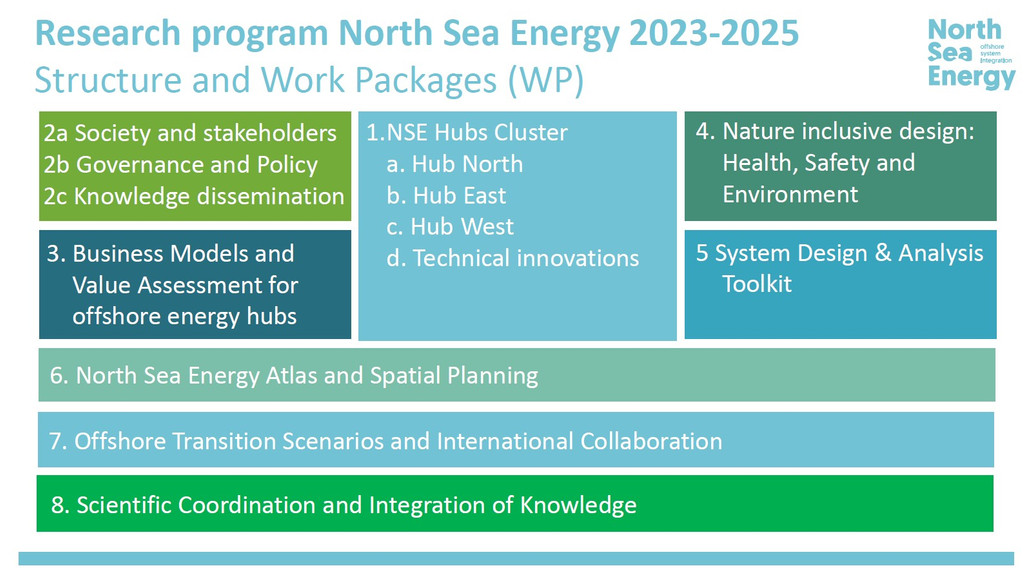Programme
Structure and work packages
North Sea Energy is a dynamic research program at the heart of which is an integrated approach to the offshore energy system. The aim is to identify and assess opportunities for synergies between multiple low-carbon energy developments offshore with optimal value for society and nature.
The North Sea provides opportunities for the integrated implementation of the future climate-neutral energy system:
- Well suited for offshore wind because the North Sea is relatively shallow and is (almost) always windy
- Possibilities for large-scale underground carbon storage
- The pivotal role in the energy supply of the North Sea countries. Initially with oil and gas production, now increasingly with renewable energy
The North Sea provides opportunities for large-scale wind energy, hydrogen production, solar and marine energy, underground carbon storage, and (re)use of natural gas infrastructure. North Sea Energy looks at the benefits of smart links between these energy functions. By connecting the infrastructure of wind energy, hydrogen, CO2 and natural gas, we will save money and time while bringing down CO2 emissions. In doing so, we will also make effective use of space and limit ecological and environmental impact. The North Sea will play a pivotal role in the success of the European energy transition.
The approach
Research projects within the North Sea Energy programme are based on the following assumptions:
- Offshore wind is undergoing significant expansion
- Hydrogen will play a key role in the future energy system
- CCS will be a part of the future energy system
- Use of existing strategic natural gas infrastructure
These starting points form the core of the work packages 1- 7. The focus is on the integrated approach and vision. We look at the issues from different perspectives: technology, market, society, ecology, spatial planning and regulations are important angles. At the same time, we want to limit the costs for society and the impact on nature.
NSE Work packages
The central pillar of the current phase of the program is the design of Offshore Energy System blueprints towards 2050 for offshore hubs in the North Sea. These are areas where new and existing energy infrastructure assets (cables, wind farms, offshore solar, marine energy options, pipelines, platforms, islands, wells etc.) may be strategically combined to reduce cost, space and time for the energy transition.
The following work packages are defined allowing for the hubs design process. They also give input to national and international offshore transition scenarios with an associated action plan to spur development on the short and long-term.
Uptake of energy functions within the programme
Gradually, since 2017, the various energy functions have been included into the programme’s research projects.
- At first instance we looked at the increasing activities around offshore wind, the possible linkages with existing offshore infrastructure and the connection with other North Sea users (see Energy Atlas).
- The first studies focused on the added value of platform electrification (platform power supplies coming from wind energy instead of gas) as a first step towards system integration.
- The results from these studies, supplemented with Carbon Capture Storage (CCS), were tested in a follow-up study at two demonstrative locations (IJmuiden Ver and Hollandse Kust).
- In 2019, the insights were used to carry out an in-depth study of the technical, economic, ecological and social feasibility. The results were elaborated in scenarios including the production and transport of hydrogen and presented in the report Unlocking potential of the North Sea.
- By the end of 2022, a roadmap is delivered, for offshore system integration in the North Sea towards 2050 in which the multidisciplinary results from all phases of the programme are the ingredients. It will include practical timelines to develop system integration projects and assess whether the transition to the new energy system is creating barriers to aligning investment agendas with infrastructure developments, and how to resolve them.
- The programme selects three offshore locations in the North Sea that will act as energy hubs bringing together the different energy functions so that we can develop more in-depth scenarios in the areas of techno-economics, ecology and environment, logistics, regulation and safety.
- The development of this roadmap will be a joint effort of the partners within the consortium and outside the project, in which co-creation and sharing of knowledge plays a key role. In line with this, routes of action will be developed to actually deliver concrete system integration projects / pilots and demonstrations as a spin-off of this phase of the programme.
Click on the work packages for more information:
- North Sea Energy Hub clusters and Technical Innovations
- Society. governance & Communication
- Business Models and Value Assessment for offshore energy hubs
- Nature inclusive design
- System design and analysis tool
- North Sea Energy Atlas and Spatial Planning
- Offshore transitions scenarios and international collaboration
- Scientific integration and coordination activities
